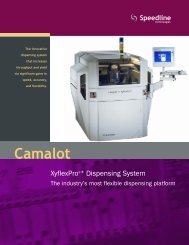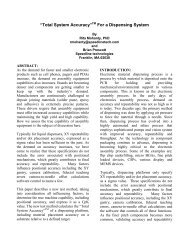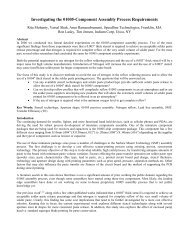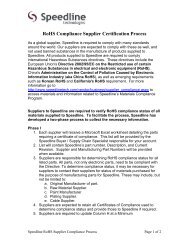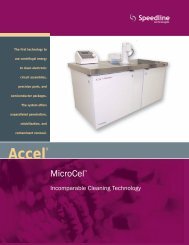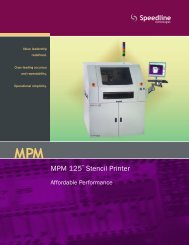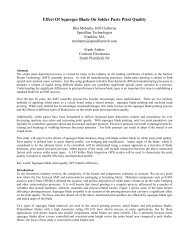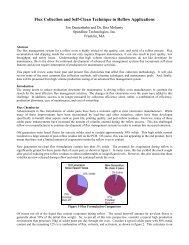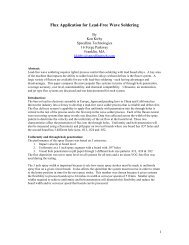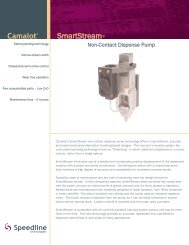Substrate Bumping for Micro BGA - Speedline Technologies
Substrate Bumping for Micro BGA - Speedline Technologies
Substrate Bumping for Micro BGA - Speedline Technologies
You also want an ePaper? Increase the reach of your titles
YUMPU automatically turns print PDFs into web optimized ePapers that Google loves.
varying plating rates required <strong>for</strong> the Pb-free solders<br />
that are typically ternary alloys, electroplating has<br />
difficulty controlling compositions. In general,<br />
ternary alloys are a greater challenge because they<br />
require more complex equipment and photo-resist<br />
processing. Solder paste printing, on the other hand,<br />
offers greater composition control and material<br />
flexibility to support Pb-free alloys.<br />
Background:<br />
Though there are several advantages to the<br />
solder paste printing process, there are also<br />
challenges and limitations associated with printing.<br />
Namely, these are printing solder paste deposits that<br />
are large enough to produce bumps with the required<br />
height and co-planarity within the constraints of the<br />
pitches. The difficulty lies with the stencil<br />
manufacturing technologies and solder paste<br />
limitations. When printing full area array designs, the<br />
slumping of the overprinted solder paste results in<br />
solder robbing during reflow process. There<strong>for</strong>e, it is<br />
very important to use a paste and stencil technology<br />
which promotes easy release of the paste and has<br />
adequate slump resistance during print and reflow. In<br />
this study, per<strong>for</strong>mance of two different paste<br />
chemistries is evaluated.<br />
The following factors are critical to achieve<br />
successful bumping using solder paste printing:<br />
• Printing technique<br />
• Stencil design<br />
• Paste <strong>for</strong>mulation<br />
• Reflow process<br />
• <strong>Substrate</strong> flatness<br />
The current study focuses on the printing part of the<br />
bumping process. Printing is a highly complex<br />
process and is considered to be “black magic” by<br />
many experts. The goal here is to demystify the<br />
printing process through a series of well designed<br />
experiment. Results from the evaluation of the<br />
printing technique and paste chemistries are<br />
presented in this paper.<br />
Test Vehicle:<br />
The test vehicle used <strong>for</strong> the study was a two<br />
layer FR4 substrate. The thickness of the substrate<br />
was 0.012” with 0.5oz copper and Immersion Nickel<br />
Gold (ING) pad finish. The substrate was designed to<br />
include extreme cases, (extremely small pad size and<br />
web size) to understand the limitation of the stencil<br />
printing capability. The pad size varied from 200µ to<br />
65µ, as shown in figure 1. In addition to various pad<br />
sizes, the pitch/web was also varied to understand the<br />
effects of the above factors on the printing capability.<br />
The details of the pad size, pitch and web dimension<br />
are shown in table 1. Figure 2 shows an expanded<br />
view of an 200µ (8mil) pad design. For better data<br />
management, each group of pads was assigned a<br />
location number., the top left group being LN1 and<br />
the bottom right being LN36.<br />
Each location contained an array of 25X25 pads.<br />
Some arrays were repeated on the board to<br />
understand the printing characteristic as a function of<br />
location. To keep the scope of the initial experiment<br />
manageable, only the areas shaded in white (10X10)<br />
were inspected <strong>for</strong> transfer efficiency data.<br />
Web<br />
150µ LN1<br />
125µ<br />
100µ LN3<br />
LN36<br />
Pad size 200µ 175µ 150µ 125µ 100µ 65µ<br />
Figure 1. Test Vehicle showing pad locations used in the SPI inspection scheam.




